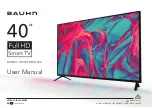
4
Important safety instructions
15
The apparatus shall not be exposed to dripping or splashing and that no objects filled
with liquids, such as vases, shall be placed on the apparatus.
16
The mains plug or appliance inlet is used as the disconnect device, remain it readily
operable during the apparatus normal use.
• Use No. 10 AWG (5.3 mm
2
) copper, No. 8 AWG (8.4 mm
2
) aluminum, No. 17 AWG
(1.0 mm
2
) copper-clad steel or bronze wire, or larger, as a ground wire.
• Secure antenna lead-in and ground wires to house with stand-off insulators spaced
from 4-6 feet (1.22 -1.83 m) apart.
• Mount the antenna discharge unit as close as possible to where lead-in enters
house.
• Use jumper wire not smaller than No. 6 AWG (13.3 mm
2
) copper, or the equivalent,
when a separate antenna-grounding electrode is used. See ANSI/NFPA70.
• An outside antenna system should not be located in the vicinity of overhead power
circuits, or where it can fall into such power lines or circuits. When installing an outside
antenna system, extreme care should be taken to keep from touching such power lines
or circuits as contact with them might be fatal.
• For added protection for the TV during a lightning storm, or when it is left unattended
and unused for long periods of time, unplug it from the power outlet and disconnect it
from the antenna or cable system. This prevents damage to the TV due to lightning
and power line surges.
Reference
Grounding component
1
Electric service equipment
2
Power service grounding electrode system (NEC Art 250, Part H)
3
Ground clamp
4
Grounding conductors (NEC Section 810-21)
5
Antenna discharge unit (NEC Section 810-20)
6
Ground clamp
7
Antenna lead-in wire
6
7
5
2
1
3
4





































